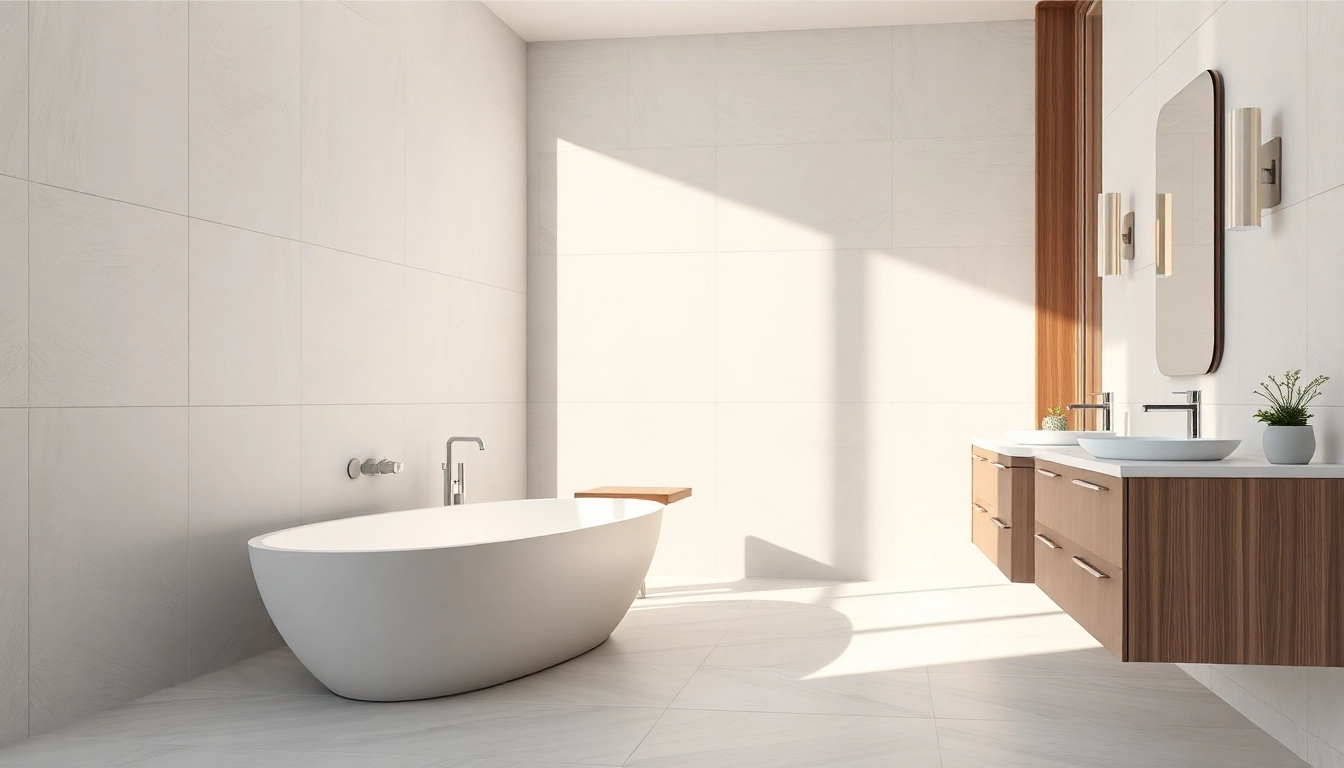Understanding Bathroom Remodeling Contractors
When considering a bathroom remodel, the first step is identifying the right Bathroom Remodeling Contractor. These professionals are skilled at transforming spaces to enhance functionality, aesthetics, and value. Whether you’re updating outdated fixtures or undertaking a complete overhaul, understanding the role of a bathroom remodeling contractor is essential to ensuring the project’s success.
Who is a Bathroom Remodeling Contractor?
A bathroom remodeling contractor is a construction professional specializing in the design and construction of bathrooms. They possess a wealth of knowledge regarding plumbing, electrical systems, tiling, and general construction practices. These contractors can manage every aspect of a bathroom renovation, from initial consultations and design layouts to the final touches that bring your vision to life.
Why Hire a Professional Contractor for Remodeling?
Hiring a professional bathroom remodeling contractor offers numerous benefits:
- Expertise: Contractors understand the complexities of bathroom installations and renovations, ensuring compliance with local building codes and regulations.
- Time-Saving: Bathroom remodeling can be time-consuming. Contractors have the capability to efficiently manage the project timeline and ensure timely completion.
- Quality Assurance: Professionals have access to the best materials and specialized tools, leading to a higher quality of work compared to DIY projects.
- Problem-Solving: Experienced contractors can anticipate and mitigate potential issues, avoiding costly mistakes that could derail the project.
What to Look for in a Contractor
Choosing the right contractor is pivotal to the success of your bathroom remodel. Here are some key factors to consider:
- Licensing and Insurance: Ensure the contractor is licensed and insured to protect yourself from liability in case of accidents or damage during construction.
- Experience: Look for a contractor with a proven track record in bathroom renovations, preferably with a portfolio showcasing past projects similar to yours.
- References and Reviews: Check online reviews and ask for client references to get insights into the contractor’s reliability and workmanship.
- Contract Terms: A reputable contractor will provide a clear, written contract outlining the scope of work, payment terms, and project timeline.
Planning Your Bathroom Remodel Project
With an understanding of what a bathroom remodeling contractor offers, the next step is to plan your project effectively. Successful bathroom renovations start with solid planning.
Setting Your Budget for a Remodeling Contractor
Establishing a budget is the cornerstone of your remodeling plan. Factors to consider include:
- Cost of Materials: Determine the types of materials you want to use, as this will significantly impact your overall budget.
- Labor Costs: Factor in the cost of hiring a contractor, which typically ranges from 10% to 20% of the overall project cost.
- Contingency Fund: Set aside an additional 10-15% of your total budget for unforeseen expenses that may arise during the project.
Choosing the Right Style and Design
The design of your bathroom should reflect your personal style while maximizing functionality. Consider the following:
- Space Optimization: Efficiently use the available space to accommodate essential amenities without feeling cramped.
- Color and Texture: Choose colors that promote relaxation, such as soft blues and greens, and consider various textures to add depth and interest.
- Accessibility: If aging in place is a priority, ensure your design accommodates accessibility features, such as grab bars and walk-in tubs.
Timeline and Scheduling with Your Contractor
Once your budget and design have been established, work with your contractor to outline a detailed project timeline. Factors influencing the timeline include:
- Permit Approvals: Ensure all necessary permits are secured before construction begins to avoid delays.
- Source of Materials: Timely ordering of materials is critical, as delays in shipments can push back your project timeline.
- Contractor Availability: Discuss your contractor’s availability and schedule to align your timelines effectively.
Common Bathroom Remodeling Challenges
No remodeling project is without its challenges. Anticipating and preparing for these obstacles can significantly ease the process.
Identifying Potential Issues Before They Arise
Common issues during bathroom remodeling include:
- Plumbing Problems: Existing plumbing may need adjustments. Inspect pipes and fixtures early.
- Electrical Concerns: Upgrading old electrical systems must comply with current codes and potentially require rewiring.
- Mold and Mildew: Be vigilant about mold behind walls or under flooring; these issues may lead to costly repairs later.
How to Communicate Effectively with Your Contractor
Effective communication can prevent misunderstandings and ensure project success.
- Regular Check-Ins: Schedule weekly updates to review progress and address any questions or concerns promptly.
- Use Visual Aids: Share inspiration images and sketch layouts to ensure clarity on your vision.
- Be Open to Feedback: Your contractor may provide valuable insights based on their experience; listen to their suggestions.
Managing Expectations Throughout the Project
Set realistic expectations regarding the duration and outcomes of your remodeling project. Remember:
- Delays are Possible: Construction projects often face unexpected delays, be patient and flexible.
- Quality Takes Time: Rushing through can compromise quality; trust the process for optimal results.
- Design Adjustments: Be prepared to make minor changes to your original design if budget or structural limitations arise.
Best Practices for Successful Bathroom Renovations
Adopting best practices can enhance the success of your bathroom renovation, ensuring a well-planned and executed project.
Maximizing Space with Design Innovations
Innovative designs can make a small bathroom feel spacious:
- Floating Fixtures: Wall-mounted sinks and toilets save floor space and create an airy feel.
- Mirrored Surfaces: Strategically placing mirrors can reflect light and make the area appear larger.
- Smart Storage: Use vertical space for storage solutions, such as shelving or cabinets that go up to the ceiling.
Incorporating Eco-friendly Materials
Consider sustainability by selecting eco-friendly materials and finishes. Examples include:
- Low-VOC Paints: These reduce volatile organic compounds, meaning better air quality.
- Recycled Materials: Use tiles and countertops made from recycled materials for style and sustainability.
- Water-Efficient Fixtures: Install low-flow toilets and showerheads to conserve water without sacrificing performance.
Ensuring Quality Through Contractor Collaboration
Quality outcomes are often a product of teamwork. Foster a collaborative relationship with your contractor by:
- Staying Involved: Be an active participant in the project, offering input and feedback as necessary.
- Establishing a Payment Schedule: Align payments with project milestones to maintain accountability.
- Reviewing Work Thoroughly: Regularly check the construction against the initial plans and specifications.
Measuring Success in Your Bathroom Remodel
Once the project is complete, it’s crucial to evaluate its success based on various quantitative and qualitative factors.
Evaluating Budget vs. Actual Costs
Review your original budget against actual expenditures to understand financial performance:
- Cost Overruns: Analyze any discrepancies to identify where the project deviated from the budget and how to avoid this in future projects.
- Value for Money: Assess whether the final outcome justifies the investment based on functionality and aesthetics.
Feedback from Homeowners: What Works Best?
Collecting feedback post-remodel can provide insights into the project’s effectiveness:
- Surveys: Create surveys for homeowners to gather detailed information about their satisfaction.
- Social Media Engagement: Monitor online conversations regarding the remodel to obtain honest opinions.
Follow-up Post-Remodel: Maintenance and Care
Maintaining your new bathroom is as critical as the remodeling process. Follow these tips for ongoing care:
- Regular Cleaning: Establish a cleaning routine to keep surfaces and fixtures in pristine condition.
- Inspect for Issues: Periodically check for leaks or damage to prevent minor issues from escalating.
- Customer Service: Maintain communication with your contractor, who can provide guidance on any post-remodel questions or concerns.









